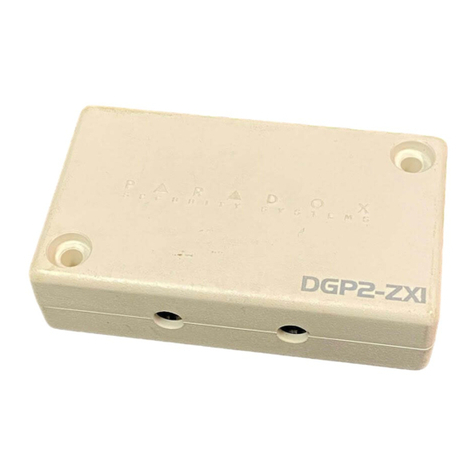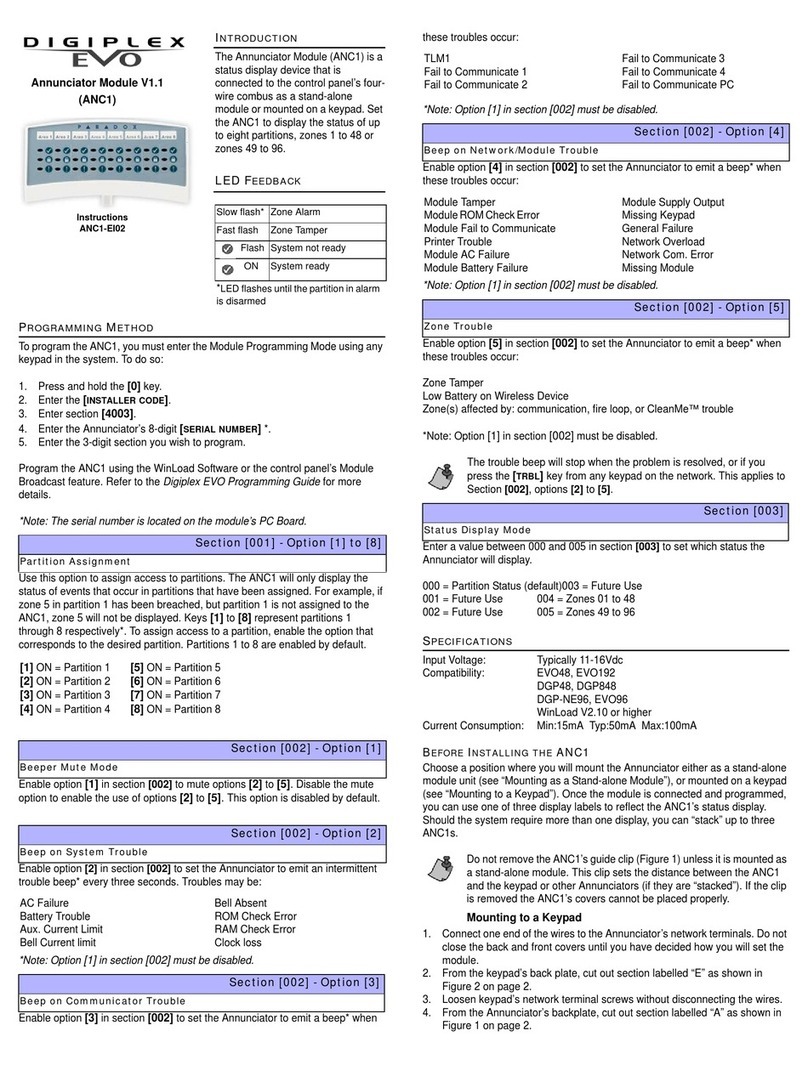
INTRODUCTION
The Annunciator Module (DGP2-
ANC1B) is a status display device
that is connected to the control
panel’s four-wire combus as a stand-
alone module or mounted on a
keypad. Set the DGP2-ANC1 to
display the status of up to eight
partitions, zones 1 to 48 or zones 49
to 96.
LED FEEDBACK
PROGRAMMING METHOD
To program the DGP2-ANC1B, you must enter the Module Programming Mode
using any keypad in the system. To do so:
1. Press and hold the [0] key.
2. Enter the [INSTALLER CODE].
3. Enter section [4003].
4. Enter the Annunciator’s 8-digit [SERIAL NUMBER]*.
5. Enter the 3-digit section you wish to program.
Program the DGP2-ANC1B using the WinLoad Software or the control panel’s
Module Broadcast feature. Refer to the Digiplex EVO Programming Guide for
more details.
*Note: The serial number is located on the module’s PC Board.
Use this option to assign access to partitions. The DGP2-ANC1B will only
display the status of events that occur in partitions that have been assigned. For
example, if zone 5 in partition 1 has been breached, but partition 1 is not
assigned to the DGP2-ANC1B, zone 5 will not be displayed. Keys [1] to [8]
represent partitions 1 through 8 respectively*. To assign access to a partition,
enable the option that corresponds to the desired partition. Partitions 1 to 8 are
enabled by default.
Enable option [1] in section [002] to mute options [2] to [5]. Disable the mute
option to enable the use of options [2] to [5]. This option is disabled by default.
Enable option [2] in section [002] to set the Annunciator to emit an intermittent
trouble beep* every three seconds. Troubles may be:
*Note: Option [1] in section [002] must be disabled.
Enable option [3] in section [002] to set the Annunciator to emit a beep* when
these troubles occur:
*Note: Option [1] in section [002] must be disabled.
Enable option [4] in section [002] to set the Annunciator to emit a beep* when
these troubles occur:
*Note: Option [1] in section [002] must be disabled.
Enable option [5] in section [002] to set the Annunciator to emit a beep* when
these troubles occur:
Zone Tamper
Low Battery on Wireless Device
Zone(s) affected by: communication, fire loop, or CleanMe™ trouble
*Note: Option [1] in section [002] must be disabled.
The trouble beep will stop when the problem is resolved, or if you
press the [TRBL] key from any keypad on the network. This applies to
Section [002], options [2] to [5].
Enter a value between 000 and 005 in section [003] to set which status the
Annunciator will display.
000 = Partition Status (default)003 = Future Use
001 = Future Use 004 = Zones 01 to 48
002 = Future Use 005 = Zones 49 to 96
SPECIFICATIONS
Input Voltage: Typically 11-16Vdc
Compatibility: EVO48, EVO192
DGP48, DGP848
DGP-NE96, EVO96
WinLoad V2.10 or higher
Current Consumption: Min:15mA Typ:50mA Max:100mA
BEFORE INSTALLING THE DGP2-ANC1B
Choose a position where you will mount the Annunciator either as a stand-alone
module unit (see “Mounting as a Stand-alone Module”), or mounted on a keypad
(see “Mounting to a Keypad”). Once the module is connected and programmed,
you can use one of three display labels to reflect the DGP2-ANC1B’s status
display. Should the system require more than one display, you can “stack” up to
three DGP2-ANC1Bs.
Do not remove the DGP2-ANC1B’s guide clip (Figure 1) unless it is
mounted as a stand-alone module. This clip sets the distance between
the DGP2-ANC1B and the keypad or other Annunciators (if they are
“stacked”). If the clip is removed the DGP2-ANC1’s covers cannot be
placed properly.
Mounting to a Keypad
1. Connect one end of the wires to the Annunciator’s network terminals. Do not
close the back and front covers until you have decided how you will set the
module.
2. From the keypad’s back plate, cut out section labelled “E” as shown in
Figure 2 on page 2.
3. Loosen keypad’s network terminal screws without disconnecting the wires.
4. From the Annunciator’s backplate, cut out section labelled “A” as shown in
Figure 1 on page 2.
Slow flash* Zone Alarm
Fast flash Zone Tamper
Flash System not ready
ON System ready
*LED flashes until the partition in alarm
is disarmed
Section [001] - Option [1] to [8]
Partition Assignment
[1] ON = Partition 1 [5] ON = Partition 5
[2] ON = Partition 2 [6] ON = Partition 6
[3] ON = Partition 3 [7] ON = Partition 7
[4] ON = Partition 4 [8] ON = Partition 8
Section [002] - Option [1]
Beeper Mute Mode
Section [002] - Option [2]
Beep on System Trouble
AC Failure
Battery Trouble
Aux. Current Limit
Bell Current limit
Bell Absent
ROM Check Error
RAM Check Error
Clock loss
Section [002] - Option [3]
Beep on Communicator Trouble
Annunciator Module V1.1
(DGP2-ANC1B)
Instructions
DGP2ANC1-EI02
TLM1
Fail to Communicate 1
Fail to Communicate 2
Fail to Communicate 3
Fail to Communicate 4
Fail to Communicate PC
Section [002] - Option [4]
Beep on Network/Module Trouble
Module Tamper
Module ROM Check Error
Module Fail to Communicate
Printer Trouble
Module AC Failure
Module Battery Failure
Module Supply Output
Missing Keypad
General Failure
Network Overload
Network Com. Error
Missing Module
Section [002] - Option [5]
Zone Trouble
Section [003]
Status Display Mode























